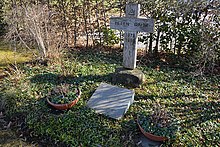Helen Dahm
Helen Dahm , or even Helen Dahm (* 21st May 1878 in Egelshofen ; † 24. May 1968 in Männedorf ) was a Swiss painter of Expressionism .
Life
Helen Dahm came from a middle-class family and was born in Kreuzlingen at Rosenegg Castle . After the bankruptcy of their father's textile company, the family moved to Zurich in 1897 , where their mother ran a pension for students. Helen Dahm received her first drawing lessons from Hermann Gattiker and Ernst Würtenberger , who urged her to continue her studies. Thanks to a scholarship, she was able to study under Julius Exter at the Academy of Fine Arts in Munich between 1906 and 1913 . Within a very short time Dahm made the acquaintance of the city's most famous artists, including Wassily Kandinsky , Franz Marc , August Macke , Gabriele Münter , Marianne von Werefkin and Alexej von Jawlensky . She was strongly influenced by the contact with the artist group Der Blaue Reiter .
In 1913, Helen Dahm moved back to Zurich with the Berlin art historian and painter Else Strantz (1866–1947), where she earned her living with product design . In addition, she dealt intensively with painting, but without much recognition. In 1919 the two women moved to Oetwil am See . After separating from her long-term partner Else Strantz in 1932, Helen Dahm fell into a serious existential crisis. In 1938 she broke up her household and moved with a group of women to the ashram of Meher Baba in India . She intended to stay there forever in search of a new spiritually fulfilled life. The main work from this period are the wall paintings for Meher Baba's tomb. After her severe illness from dysentery , Helen Dahm returned to Switzerland a year later , where she settled again in Oetwil am See.
In addition to abstract and mystical-religious works, Dahm repeatedly dealt with the representation of nature and landscape. In 1953, her work was honored by an extensive retrospective at the Helmhaus in Zurich, and this was the breakthrough she had longed for; in 1954, Helen Dahm was the first woman to receive the Zurich Art Prize. Helen Dahm died in the spring of 1968 three days after her 90th birthday in Männedorf.
At Chilerain 10 in Oetwil am See, between the church and the parish hall, there is also the local museum, to which the Helen Dahm Museum has been attached since 2008 (in the neighboring apartment). It was expanded in 2013.
Helen Dahm still turned to new painting styles in old age: “Always open and curious, she went her own way undeterred; a hard, colorful, often lonely life, but a fulfilled one. "
literature
- Tapan Bhattacharya: Dahm, Helen. In: Historical Lexicon of Switzerland .
- Helen Dahm . In: General Artist Lexicon . The visual artists of all times and peoples (AKL). Volume 23, Saur, Munich a. a. 1999, ISBN 3-598-22763-9 , p. 436.
- Artist Lexicon of Switzerland. XX. Century. Ed .: Association for the publication of the Swiss artist lexicon; Editor: Hans Christoph von Tavel. Huber, Frauenfeld 1958–1967.
- Biographical lexicon of Swiss art. Dictionnaire biographique de l'art suisse. Dizionario biografico dell'arte svizzera. Ed .: Swiss Institute for Art Research, Zurich and Lausanne; Head: Karl Jost. 2 volumes. Verlag Neue Zürcher Zeitung, Zurich 1998.
- Joseph August Beringer : Dahm, Helene . In: Ulrich Thieme (Hrsg.): General Lexicon of Fine Artists from Antiquity to the Present . Founded by Ulrich Thieme and Felix Becker . tape 8 : Coutan-Delattre . EA Seemann, Leipzig 1912, p. 279 ( Textarchiv - Internet Archive ).
- Doris Wild , Elisabeth Grossmann, Regula Witzig: Helen Dahm. ABC Verlag, Zurich 1984, ISBN 3-85504-084-2 (monograph).
- Paola von Wyss-Giacosa and Sandi Paucic: Catalog Helen Dahm. ISBN 3-905647-13-3 .
- Hanna Gagel: So much energy - artists in the third phase of life. AvivA Verlag, 2005, ISBN 3-932338-24-3 .
- Elisabeth Grossmann : Helen Dahm, artist In: Thurgauer Contributions to History , Vol. 132, 1995, pp. 7–91
Web links
- Literature by and about Helen Dahm in the catalog of the German National Library
- Elisabeth Grossmann: Dahm, Helen. In: Sikart
- Homepage of the Helen Dahm Society
- Village Antiques - Helen Dahm (English)
- Works by Helen Dahm in the Thurgau Art Museum
- Helen Dahm and the desire for zigzag In: SRF December 20, 2018
Individual evidence
- ↑ Else Strantz at L-World - The Wiki on the lesbian history of Switzerland
- ↑ helen-dahm.ch
- ↑ KFB (Katholischer Frauenbund Zürich) "visible 1919-2019". (Ed.) - Editing: Barbara Acklin. Without page indication. (Events June / July 2019)
| personal data | |
|---|---|
| SURNAME | Dahm, Helen |
| ALTERNATIVE NAMES | Dahm, Helene |
| BRIEF DESCRIPTION | Swiss painter |
| DATE OF BIRTH | May 21, 1878 |
| PLACE OF BIRTH | Egelshofen |
| DATE OF DEATH | May 24, 1968 |
| Place of death | Männedorf |


